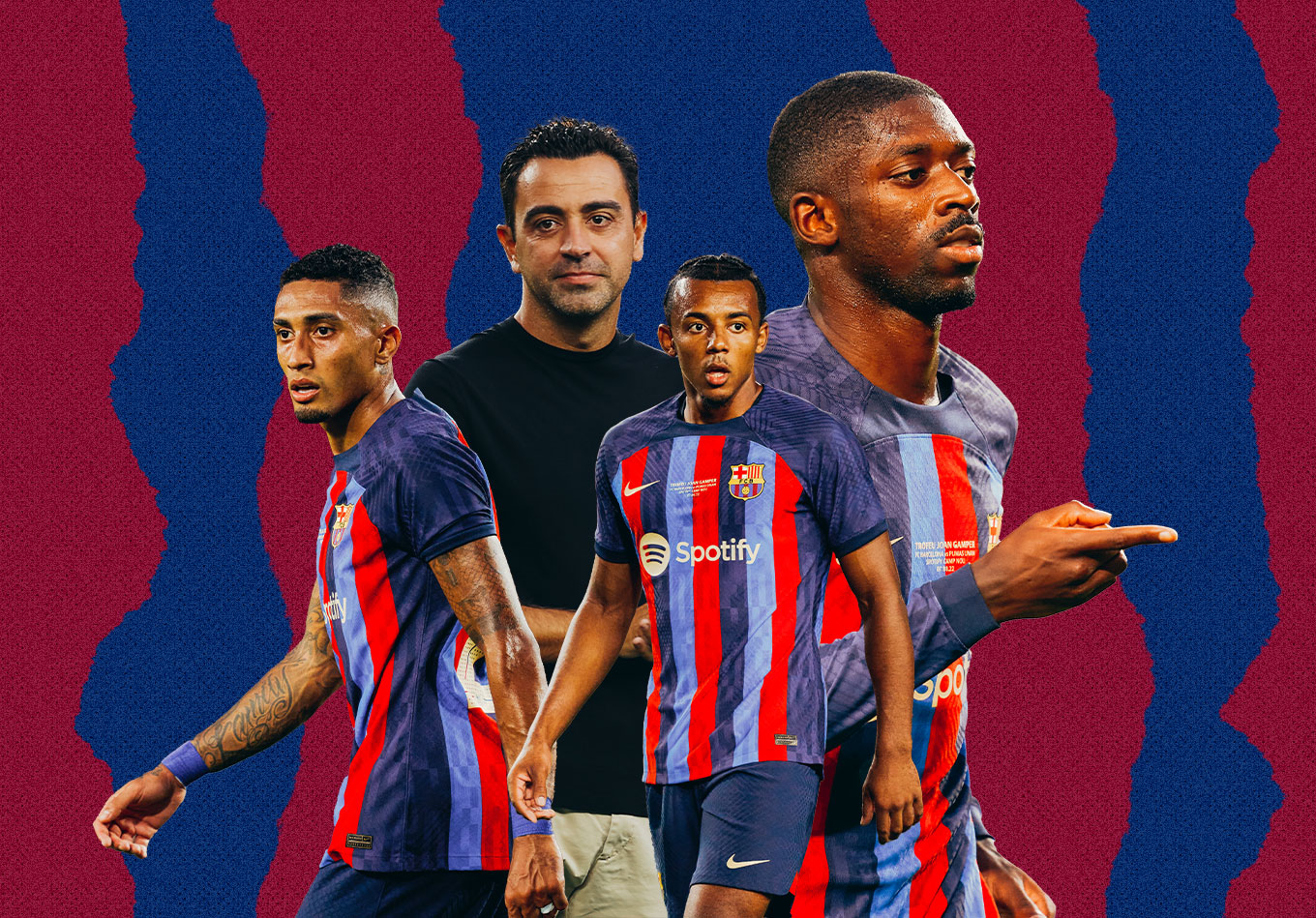On January 2, Barcelona travelled east for an evening kick-off in Mallorca. They were seventh in La Liga heading into the game and burdened by their fewest points at that stage of a season in almost two decades. The new manager, 41-year-old Xavi Hernández, had been a 23-year-old player the last time they had been this wounded.
Now, he was the man upon whose shoulders the uncertain future of Barcelona would rest. For there were few things that the club feared as deeply as what would meet them on the other side of an unsuccessful Xavi project.
A mixture of disruptions, on top of their depreciating overall state, had stripped the squad in Mallorca down to an unrecognisable form. In a front line that Lionel Messi – for many, the greatest player of all-time – had not long since occupied, Xavi’s starting XI for the match was led by a front three of Ferran Jutglà, Luuk de Jong and Ilias Akhomach.
Jutglà had made his debut in La Liga just a few weeks before, and now plays for Club Brugge. De Jong was a season-long loan and ‘plan B’ option with close ties to former coach Ronald Koeman, who has since returned to Holland with PSV. And Ilias, an 18-year-old player for the B team, hasn’t made an appearance in La Liga since that night in Mallorca.
It was a long way from Neymar-Suárez-Messi, or Villa-Messi-Pedro; the sharp edge of a team that someone like Joan Laporta – then just entering the race to become the club’s new President – would deem sufficient in a Barcelona team of the modern era. From that night in Palma, a return to the summit of European football seemed like an odyssey at best. And any time soon, little more than fantasy.
A lot has changed since then.
Joan Laporta is back, and with him has followed a cascade of measures designed to put Barcelona back on the top step as soon as this season. Their off-field dealings have lifted the club’s squad from a post-Messi daze, where they were neither a full-blown youth movement nor a committed ‘win now’ project, to an unequivocally world class group that is now built to fight for every honour. All in the space of seven months.
On the opening day of the 2022-23 season, Barcelona could now fill their front three positions from a selection of Ousmane Dembélé, Robert Lewandowski, Raphinha, Ansu Fati, Ferran Torres and Pierre-Emerick Aubameyang (assuming the new faces will be registered in time).
Memphis Depay, the remaining star recruit from last summer, is lodged at the back of a queue which has swelled rapidly, leaving him the chief casualty of a team which has moved heaven and earth to recoup its fangs.
Precisely how we got here has been well documented, even if the nuts and bolts are difficult to digest. Barcelona have dominated the summer news cycle with their work off the pitch – how they had done it, why they had done it and if they should have done it. Whatever the answers to those questions are, Barcelona and Xavi are emerging from pre-season in a different world. And in this one, he will have to lead a hunt for the trophies that lie on the far side of 2022-23.
Is this the beginning of a return to the utopian times that Barcelona have previously lived, or is it a crisis that football alone can no longer remedy?
Xavi and Barcelona’s Existing Foundations
Barcelona won 56 points from their 26 league games after Xavi’s appointment last season, just three fewer than champions Real Madrid in the same period. In 2022 alone, their 45 points were the most in La Liga.
Of course, that’s a simplistic version of events which doesn’t forecast the future with much precision. Real Madrid’s priority had shifted towards the Champions League in that time, with their title bid rarely threatened. Barcelona themselves suffered a dip in form towards the end of the season, particularly after their Europa League elimination and subsequent removal of honours to fight for.
A sturdier view into the future for Xavi’s Barcelona can be found by looking at performances in place of results, and specifically, how they relate to the style of play Xavi is trying to make custom at the Camp Nou. In a summer where Barcelona have swung big on adding stars at the top end of the pitch – and thus increased the depth throughout their squad – is their framework of play ready to inherit and then profit from their elevated quality?
After Xavi’s appointment last November, Barcelona made the most high turnovers per game (9.4) in La Liga and began their sequences of play higher up the field than any other team on average (44 metres from their own goal).
They also had the highest possession average (64%) and the highest field tilt (68%), which is a measure of who controls attacking territory. A field tilt of over 50% means you make more passes in the opposition’s final third than the opposition make in your defensive third.
Taken as a whole, the traditional markers of a Barcelona team – namely the control of possession and territory, combined with aggressive pressure out of possession – have been much more present under Xavi than they had been under previous boss Ronald Koeman.
This is the formula from which everything will follow for Xavi’s side. Perhaps as much in Barcelona as in anywhere in world football, the team’s performance levels and stylistic approach are fed by each other – one can’t truly work in isolation, and especially not in Xavi’s vision. At the Camp Nou, being able to win in different ways will fall behind perfecting a central idea.
“What Cruyff started, continued with Rijkaard, van Gaal, Pep, Luis Enrique, et cetera…,” Xavi told the press during pre-season. “And now we are trying to – in some way – evolve it because football evolves. You have to adapt to modern football.”
It was long assumed that Xavi, upon returning to the club, would reintroduce the purest expression of Barcelona football – at least in the wake of the Guardiola era. Almost a decade separated those two things, however, which is a long time in a sport that had been so heavily influenced by Guardiola himself in the years between.
There’s also the matter of Xavi not being able to construct his team with the benefit of Xavi, Andrés Iniesta and Lionel Messi on the pitch. Without that trio, and nearly 10 years on, the current Barcelona are more built to conquer the wings in place of dominating the centre of the chessboard.
Indeed, the star man of Xavi’s reign to this point has been Ousmane Dembélé. The Frenchman was Barcelona’s go-to source for attacking creation last term, notching 13 assists and leading the expected assists (9.3) charts by a significant margin in La Liga after Xavi’s arrival. Dembélé’s best form for the club has also been somewhat of a self-fulfilling prophecy: Barcelona looked to him to unbalance the opposition’s shape because he was so effective at it, and the team empowered him to be able to do it through deliberate strategy that prioritised his quality.
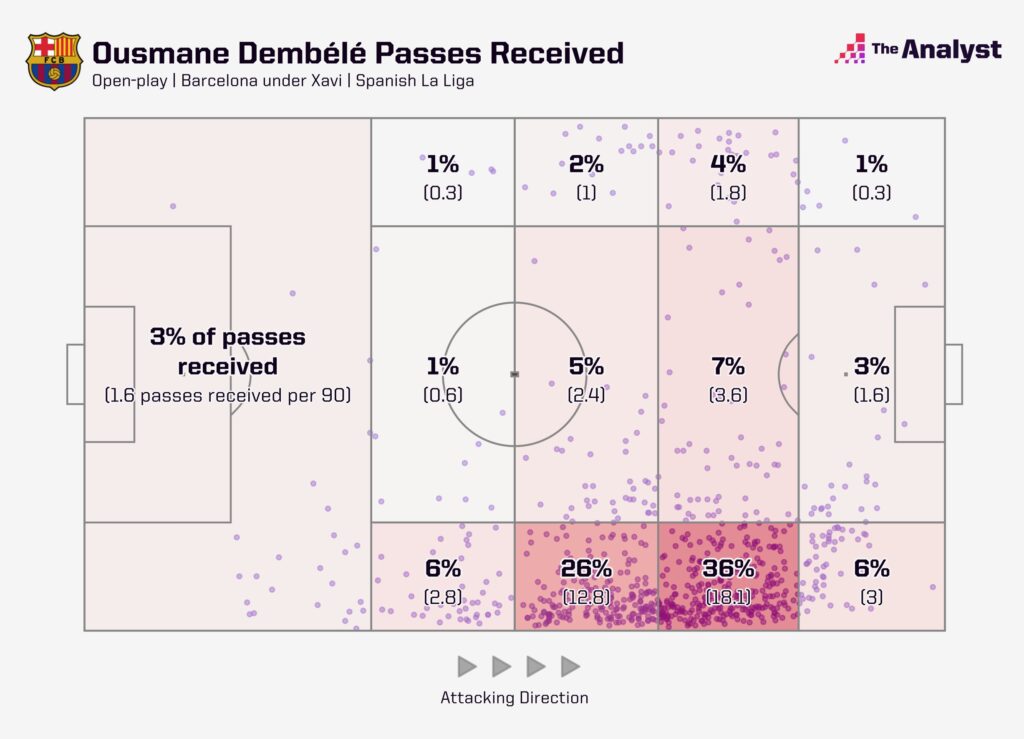
Under Xavi in La Liga last season, Dembélé received 9.7 percent of the team’s total passes when he was on the pitch. This was practically identical, if not more, than Barcelona’s three most-used central midfielders: Pedri (9.6), Frenkie de Jong (9.6) and Gavi (8.4). To compare that to the 2010-11 Barcelona under Guardiola, Xavi received 17.3% of the team’s total passes when he was on the pitch, followed by 12.6% for Andrés Iniesta. Meanwhile, their frontline wingers that season – Pedro and David Villa – received 8.0 and 4.2% respectively.
Guardiola’s team from 2010-11 were the masters of the ball and looked to their wingers to finish moves. Xavi’s version, at least until now, facilitates the ball through midfield into the wingers to create many of their advantages from there. And the fact that Barcelona’s biggest transfer fee this summer was for Raphinha – another winger to add to Dembélé, Ansu Fati and Ferran Torres – suggests that their priority on the wide areas is a theme that’s set to stick.
Enough About Style, What About Performance?
If many aspects of the traditional Barcelona style are now in process – even if a little less pure than ‘Guardiola’s Barça’ as some might have expected – how did it translate to tangible performance last term?
Under Xavi, Barcelona averaged 1.69 expected goals per game in La Liga (excluding penalties), while their opposition averaged 0.94 per game against them. Taken as an overall share – in other words, what percentage of the overall chances in a match were for Barcelona, rather than against them – Xavi’s side averaged 64% of the non-penalty expected goals in their games.
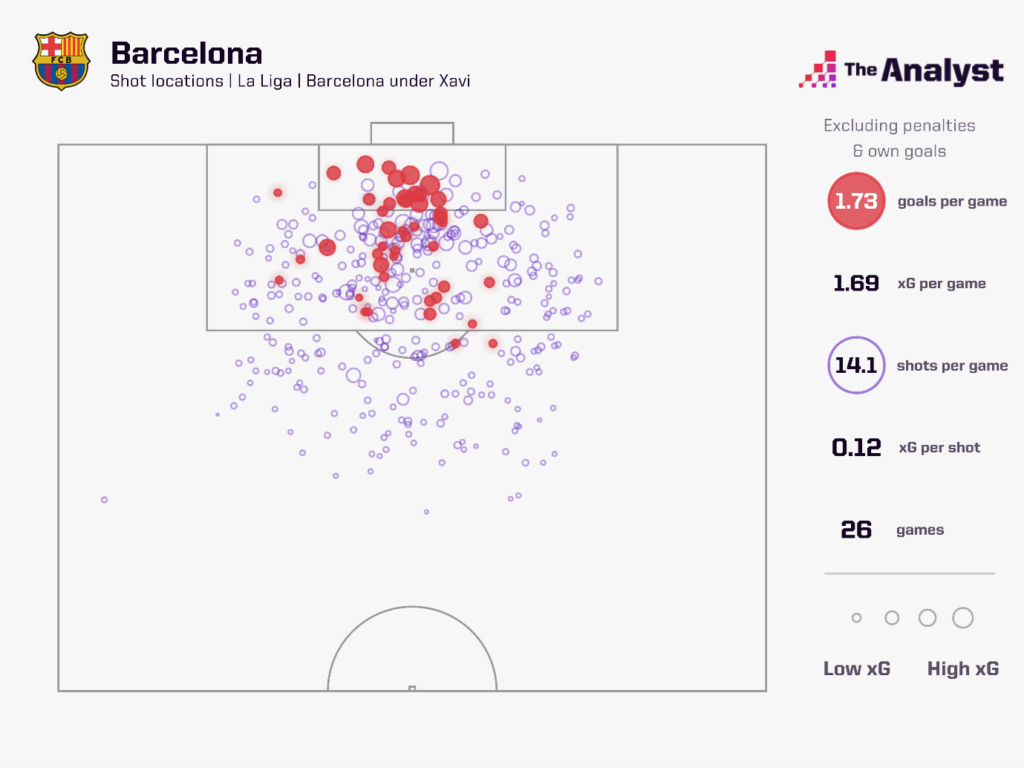
This was marginally higher than Real Madrid, while they also shared a near-identical figure for their share of non-penalty shots in La Liga in this period (both 61%). Overall, the two teams were in a similar ballpark in terms of their share of chances created in games.
What differentiated the two last season was in how closely their quality of chances created and conceded lined up with their actual goals scored and conceded. Real Madrid dominated both boxes through Thibaut Courtois at one end, and Vinícius Júnior and Karim Benzema in the other. In the case of the attacking pair, at least one of them was the scorer or assister for 69% of Real Madrid’s league goals last term (55/80) – they were the true difference-makers of the division.
Perhaps the most underrated figure in last season’s title race, however, was the man at the other end: Courtois. Although he received untold plaudits for his performance in the Champions League final, the head-to-head of performances between Courtois and Marc-André ter Stegen – the goalkeepers for the top two sides last term – were at the two opposite ends of the spectrum.
According to Opta’s expected goals on target (xGOT) data, ter Stegen conceded roughly four more goals than the quality of shots on target faced would suggest. For goalkeepers who played at least half of available minutes last term, this was the fourth-worst record in La Liga. Meanwhile, Thibaut Courtois conceded four fewer goals than expected by the same measure – the second-best rate in La Liga.
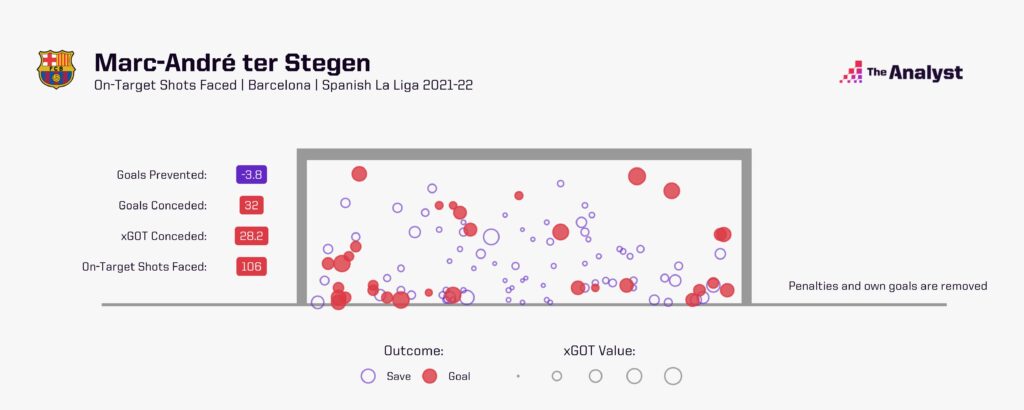
At a team level, Barcelona performed well in a defensive sense under Xavi last term. Their average of 0.94 xG against per game (excluding penalties) was virtually identical to Atlético Madrid as the league-best, while they faced fewer non-penalty shots than any other team (8.9 per game). In the context of limiting chances, Barcelona were stingier than Real Madrid from November onwards, yet ultimately came out conceding more goals than their Clásico rivals.
The question will be whether last season was an anomaly for ter Stegen given his level in previous seasons, as well as the fact that Atlético Madrid’s Jan Oblak also had a significantly poor season, compared to his typical level. That two of the top goalkeepers in La Liga performed like two of the worst in 2021-22, while Courtois exceeded his already world class reputation, was an almighty boost for Real Madrid’s title competition last term.
On the defensive side, Xavi’s side had performed like a title contender on account of limiting quality chances. At the other end, they lagged a little behind the eventual champions, who averaged 1.91 xG per game (excluding penalties) compared to Barcelona’s 1.69, and which also ranked them behind Villarreal (1.89). Hence, the conclusion that Barcelona moved to address this summer is that they have the necessary framework of play in place, but needed to close the gap on Real Madrid in their performance in both boxes.
Enter Jules Koundé – one of La Liga’s top defenders since 2019 – along with Andreas Christensen, who was part of a Chelsea side who conquered Europe on their defensive strength. If Barcelona’s defensive performance at a collective level was good enough before, they will be hoping their defensive reinforcement will result in an even tighter squeeze on opposition chances this term.
How ter Stegen ultimately fares is somewhat out of the team and Xavi’s hands, but what happens in between certainly can be influenced.
If we’re talking about penalty area proficiency, however, then Barcelona’s summer revolves around one man: Robert Lewandowski. After boosting their scoring rate with the signing of Pierre-Emerick Aubameyang in January, the arrival of Lewandowski now puts Barcelona back into elite territory at the top end of the pitch. Karim Benzema was the best player in Spain last term, but now the Catalan side will believe they have a killer of their own to rival him.
In the case of Lewandowski, much has been made of the investment made in a player who will shortly turn 34. In the here and now, though, there is little to indicate that the Pole is on any sort of decline.
He averaged 44 starts per season for Bayern Munich and made more than that in the most recent one (46). Since the 2018-19 season, which coincided with him turning 30, Lewandowski has scored more non-penalty goals than any other player in the Champions League (32) – Europe’s premier competition – and has done it with a better minutes per goal ratio than any other player to appear in each season in this period (93).
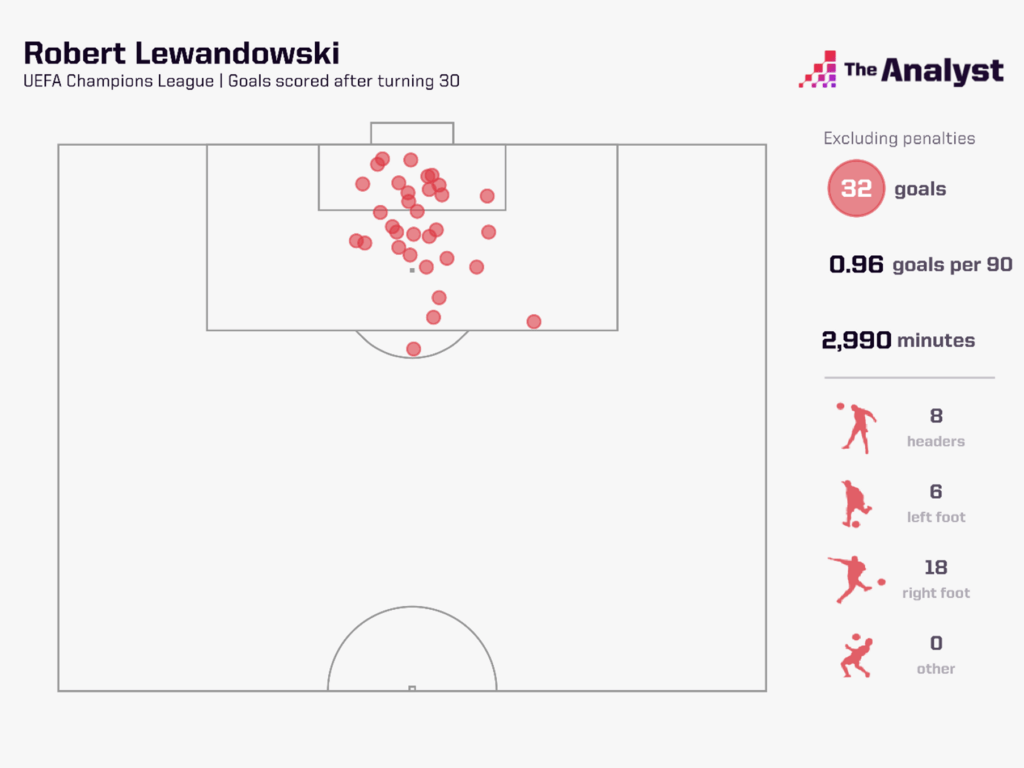
Overall, Lewandowski is the summer recruit which requires the least specific analysis. Along with scoring 40+ goals in each of the last seven seasons at club level, he has done it in a Bayern team whose style of play is not so different to Barcelona’s in the domination of possession and territory, and where his value to the team is primarily made by executing in congested penalty areas.
His time playing under Guardiola will also act as a good proxy for what he will find at the Camp Nou, where involvement in general play and creating space for others will be part of the remit. All in all, Lewandowski arrives in Barcelona with a game as complete as it’ll ever be, and with no immediate signs that father time is encroaching on his ability to put it into practice.
Barcelona’s Recruits Bring Variety, Not Just Quality
Although the primary reason for spending big this summer was to bring Barcelona’s quality in line with other top level teams, and in turn build stronger depth, they also open up further strategic possibilities for Xavi to work with.
Starting with the defenders, both Christensen and Koundé are highly compatible with three centre-back systems. Christensen played in a three under Antonio Conte and Thomas Tuchel at Chelsea, while Koundé’s natural attributes and ability to play as a right back makes him a strong candidate to figure as an outside centre-back.
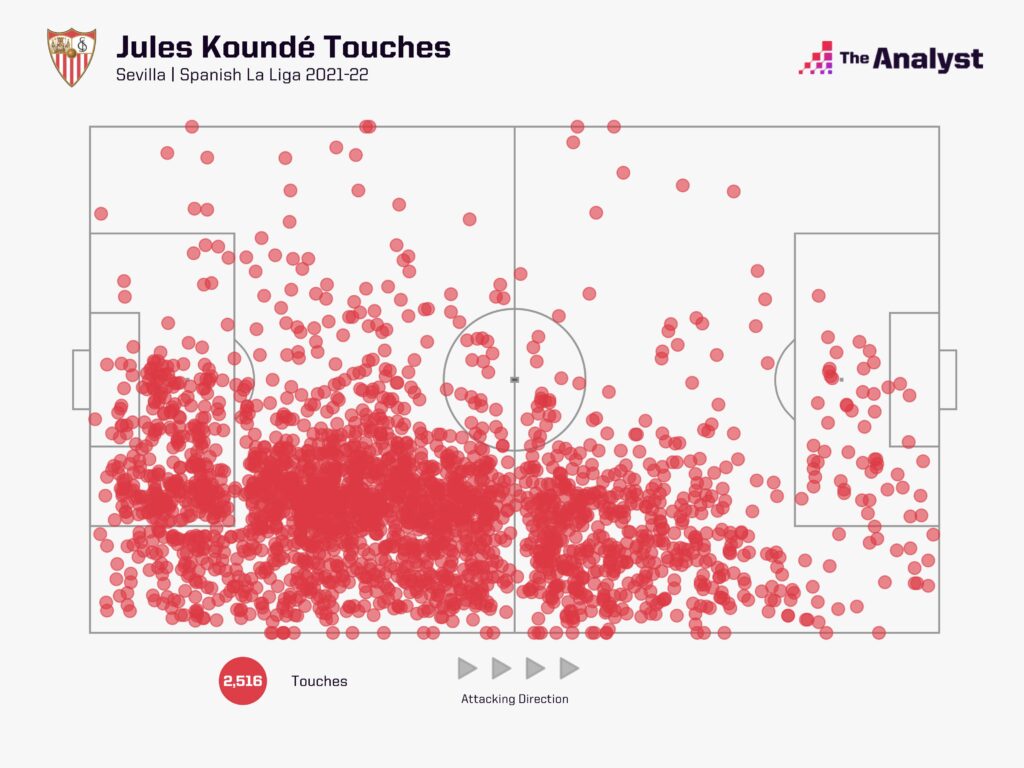
Indeed, one of the primary consequences of Barcelona’s summer is that their defensive options are now heavily favoured towards natural centre-backs over full backs. This means that even without playing an obvious 3-4-3 from the off – a system which Xavi used at times last season and has hinted towards using more in the coming season – Barcelona might end up looking a lot like they are in practice.
“The 3-4-3 is a risky system because you leave a lot of space behind, but in certain moments we can use it, yes,” Xavi said during pre-season. “It’s one of the possibilities we have. We’ll see. At the moment we’re working with the 4-3-3, but the idea is also to attack and finish (moves) with a 3-4-3.”
By playing with a back three, it would also allow Barcelona to make use of more of their expanded group of wingers – which brings us on to Raphinha.
The addition of another player with a very wide starting position, when combined with the team’s strong stock of centre backs, can permit Xavi to sneak in extra attackers depending on the scenario. For example, in games at the Camp Nou where they’re bound to have 70% or more of the ball, or where they have to come from behind late on, Barcelona can move to form a 3-4-3 shape where the likes of Raphinha can occupy the wing-back spot in practice, but still maintain an aggressive attacking position with three centre-backs covering behind.
In a more orthodox sense, however, this summer’s arrival of Raphinha can have a double-edged effect in general play. The Brazilian has shown in pre-season what impact he can make in possession against deeper defences, where more precise creation is required, but comes from a recent history of impacting games heavily in transition.
During his spell with Leeds, Raphinha was one of the Premier League’s most dynamic wingers in terms of combining ball-carrying and movements without the ball. And particularly when Raphinha and Dembélé share the pitch, Barcelona will pack a serious counter-punch in phases of the games where they have to start from deeper positions.
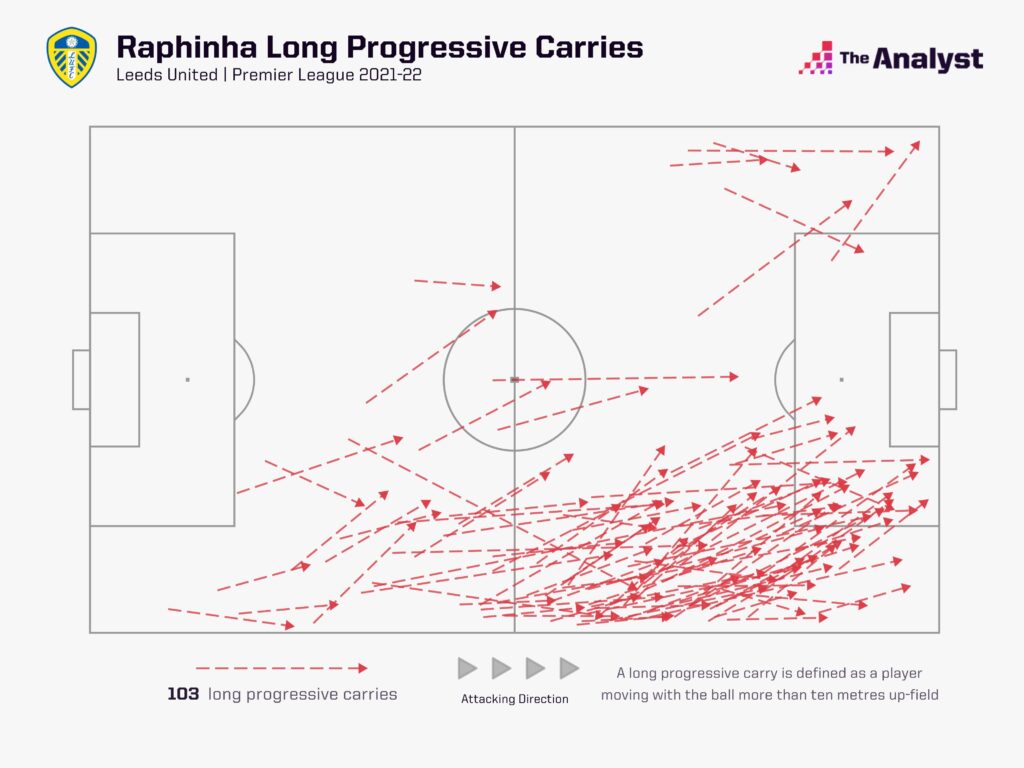
As we saw last season and also in this pre-season, Barcelona have been looking to catch teams out with long balls from deep, as well as directly from goal kicks. Although he seeks control of play, Xavi doesn’t want his side to make three passes if a well-executed one can get them to goal quicker. Adding Raphinha into the mix strengthens his options for by-passing pressure from opponents, due to his speed and commitment to off-ball movements.
The final piece of the jigsaw for Barcelona is, of course, Lewandowski. While his scoring record is well established, he is a more complete player to lead the line than Aubameyang, especially in the context of playing for Barcelona.
Lewandowski is a more secure player when dropping out of the front line to involve himself in play, as well as a stronger target to play into with defenders on his back. While Aubameyang is more suited to playing with space ahead of him, where his speed can bother defenders, Lewandowski’s success with Bayern Munich has been more in line with the role of a number nine in one of the world’s top teams. Playing against teams who sit deep and where he’s constantly fighting the battle for space in and around the penalty area has been his weekly grind for many years.
Xavi’s increased options in terms of strategy likely won’t result in concrete changes, but they will help increase Barcelona’s proficiency in different types of scenarios. Across a season where they could be playing 50+ games, and where they will be expected to compete for every trophy, they are going to run into many different challenges.
From trying to crack through deep blocks at the Camp Nou in La Liga to Champions League games against sides who will perhaps be able to wrestle possession away from them, Barcelona head into 2022-23 with a better squad, but also a more varied one to face up to a season’s worth of obstacles.
A Healthy Pedri Leads Barcelona’s Youth Drive
Here’s a stat: Pedri played fewer minutes than Óscar Mingueza in La Liga last season. Mingueza started three games in the competition under Xavi, was never really considered for minutes outside of situations that necessitated his involvement and has since been sold.
Here’s another: Barcelona’s win percentage under Xavi in the 10 league games when Pedri played was 90%, with zero defeats. Three of their nine wins came from three games against Real Madrid, Atlético Madrid and Sevilla; the other sides who made up last season’s top four. And in the 16 league games under Xavi when Pedri didn’t play, Barcelona won only half of them and lost at home to Real Betis, Cádiz, Rayo Vallecano and Villarreal.
Are Barcelona going to win 90% of their league games when Pedri plays next season? No.
The question, rather, is what difference he would make in one where he doesn’t play half as many minutes as Toni Kroos and Luka Modrić – his opposite numbers across the Clásico divide. Pedri is an essential figure for Xavi, and despite his age, perhaps the most irreplaceable player in the team’s front six for making the Barcelona machine function.
Pedri is Xavi’s football theory brought to life.
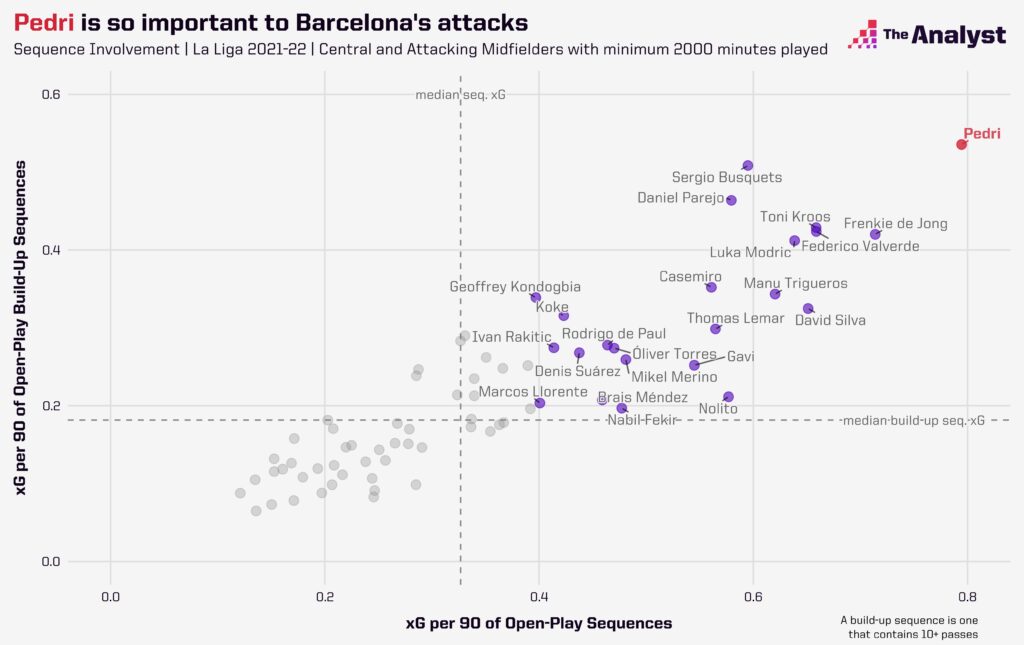
Until recent advancements in football data, Pedri had been one of those players whose game could never really be reflected in the numbers – in some ways, of course, it never will be in its entirety. With the obvious lack of goals and assists, however, Opta’s sequence data offers a window into his effect on the team’s general play.
Across the last two seasons in La Liga, the 19-year-old leads all central and attacking midfielders for his involvement in open play sequences when valued by xG (0.79 per 90). In other words, this metric captures how effective a player has been in contributing to chance creation in sequences of play that involve him.
Similarly, Pedri also tops the ranking in his position group for his involvement in build-up sequences of play (0.54 xG per 90) – highlighting his role in facilitating chance creation at the end of longer spells of play.
As previously mentioned, the likes of Pedri and Gavi don’t currently have the weight of involvement that midfielders in the Guardiola era previously did. Of course, that has a lot to do with their age, along with the changing environment in the years after Guardiola. Pedri’s effect on the current side is overwhelming proof, however, of just how important the midfield area remains to Barcelona. It was plainly evident what the team lost in his absence last term.
With an active pre-season under his belt and a clean bill of health, Pedri will return in 2022-23 as the face of a wider youth drive at Barcelona. The difference is that now, following the off-season, that core of youth players is embedded within one of Europe’s best playing squads. That hadn’t been the case in the immediate aftermath of Messi’s departure, whereby Pedri’s responsibility was transformed in a Barcelona team looking for reasons for optimism.
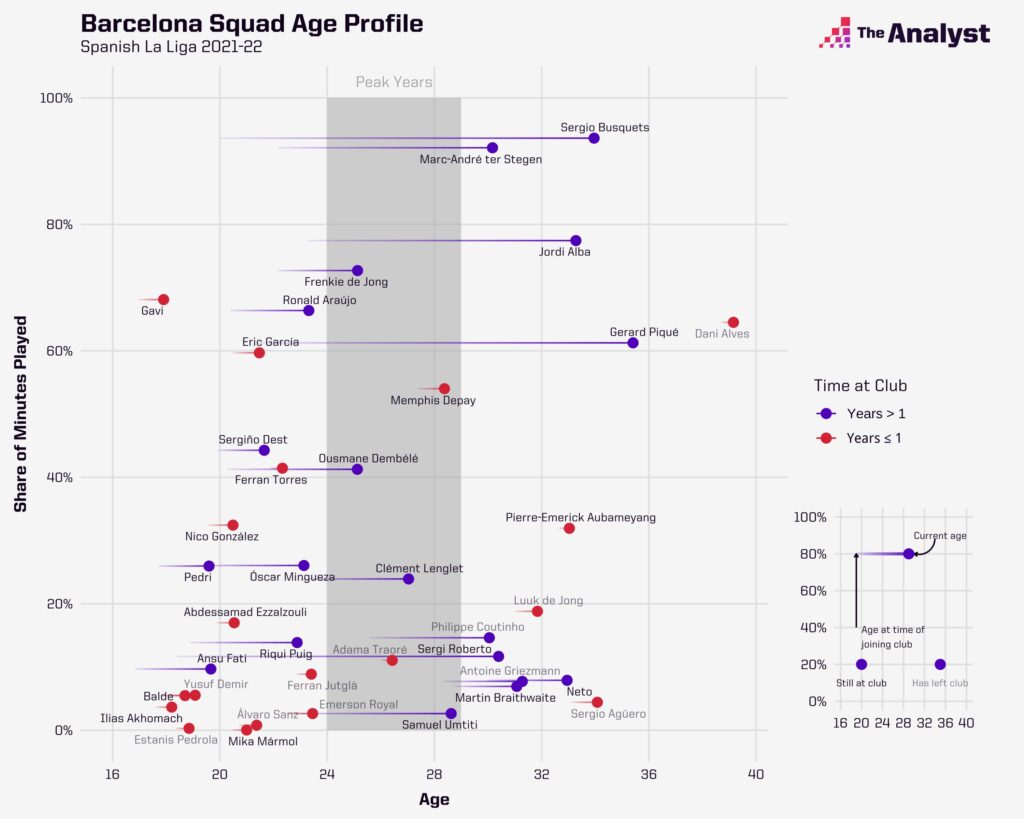
At present, the club now have reason to believe they’ve landed the best of both worlds in terms of their playing personnel: a squad capable of competing with the best immediately, as well as a young outer edge that can mature from within what they hope will be one of European football’s high-achieving projects in the coming years.
Pedri, Gavi, Ronald Araújo, Ansu Fati, Jules Koundé, Eric García and Nico González are all between the ages of 18 and 23, and will take up a significant portion of Barcelona’s minutes next season. Indeed, even those a little higher up the age scale can still be considered as part of a youthful squad. Between the team’s winger options in Dembélé, Raphinha, Torres and Fati, the oldest in the group are still only 25 (in the case of the former two).
With a young manager in tow – one who the club have placed an unwavering amount of faith in to lead their resurgence – Barcelona have transformed their on-pitch product from one that was ascendent into one that could now feasibly shake up the landscape of European football. And at the same time, they will aim to do so with one of the leading cores of youth talent across the entire continent.
A lot has changed since those days following Messi’s exit. Just when it seemed like, at last, Barcelona were back among the mere mortals of the sport, facing a period of helplessly watching their rivals Real Madrid dominate the domestic scene, the return of Xavi and Joan Laporta has catapulted the Blaugrana back into contention.
Not only in Spain, but perhaps in Europe too.
Enjoy this? Subscribe to our mailing list to receive exclusive weekly content.
